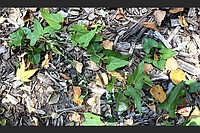Q: I found this caterpillar eating my swamp milkweed today. I had seen a few smaller ones this week in my garden around the orange butterfly milkweed and the purple coneflower. Do you know what it is? And I didn't think anyone but monarchs ate milkweed.
A: The caterpillar is from the milkweed tussock moth, another insect that feeds on milkweeds. The moth's bright coloration from feeding on the milkweed sap is fair warning to predators that it is not good to eat. In this case, the caterpillar is much more attractive than the adult brown moth.
■ ■ ■
Q: Dear Goddess of the Garden! I have several questions for your fertile wisdom. I am sending several pictures of invading, deep-rooted weeds/plants — that are marauding in the garden of a 79-year-old blood-clotted geezer — in hopes of getting your advice on how to get rid of them and then proceed to mulch properly in order to diminish their return potential.
A: Weeds are the bane of many a gardener. You, unfortunately, have three difficult-to-eradicate perennial weeds. The first one is an invasive vine called honeyvine. The second one is nutgrass, and the third is in the nightshade family and called horse nettle. Spot-spraying with Roundup will give some control, but if you can pull them up, roots and all, that would be a better option. But I know that is easier said than done. An herbicide called SedgeHammer also can be used on the nutgrass.
Photo Gallery
In The Garden — August 21, 2021
Photographs to accompany Janet Carson's "In the Garden" column for August 21, 2021.
Q: I have always had good luck with New Guinea impatiens, but not this year. Do you have any advice?
A: The original New Guinea impatiens were touted as sun-loving impatiens. While they will tolerate more sunlight than most impatiens, they require much more water in the sun and can struggle if it is hot and dry. Sunpatiens are a newer form of impatiens that can take the sun. I have planted them in full sun to partial shade, and normally they grow equally well in both exposures. This year, the ones with some afternoon shade seem to have fared better than those in all-day sun, but they are still growing. Is the soil in your container well-drained? If the soil is heavy and stays wet or waterlogged, that can be a death knell to impatiens.
■ ■ ■
Q: Can you tell me what these droppings or eggs are, and what they may have come from? This is on one of my tomato plants. The stem above is where a leaf was. No signs of worms. This happens at night.
A: Keep looking closely. With droppings that large, the caterpillar has to be getting big. I suspect a tomato hornworm. When they attack, they can decimate a plant quickly.
Retired after 38 years with the University of Arkansas Cooperative Extension Service, Janet Carson ranks among Arkansas' best known horticulture experts. Her blog is at arkansasonline.com/planitjanet. Write to her at P.O. Box 2221, Little Rock, AR 72203 or email jcarson@arkansasonline.com

